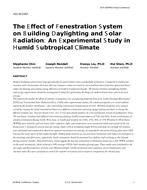Modern buildings tend to have large glass facades for good outdoor view and daylight utilization. Compared to traditional masonry wall construction, the lower thermal resistance values can result in increased heat losses (and solar gains) and hence reduce the heating and cooling energy efficiency of modern transparent facades. The balance between daylighting benefits and energy requirements should be investigated in detail for optimizing the design of modern fenestration systems by local climate.
This experiment studies the effects of window orientation, size, and glazing properties (low-e) on Useful Daylight Illuminance (UDI) and Transmitted Solar Radiation (ESR). Unlike other experimental studies, the window properties are varied without replacing the window installation – thus controlling construction-related sources of error. Window properties were instead varied by rotating the wheel-mounted test house to a different orientation and using opaque polystyrene foam to change the effective window size. Two test houses (1.8 x 1.8 x 2.4 m) were placed outdoors in a hot and humid climate of southeastern Texas. The test houses’ windows had different low-emissivity glazings (visible transmittances of 74% and 64%). Seven combinations of window orientation (facing North, West, East, or South) and window size (16%, 25%, 36%, or 47% Window-To-Wall Ratio (WWR)) were tested for each test house. Solar radiation, light, and temperature were monitored inside and outside of the test houses every 5 minutes for several days per setting. Daily UDI at workplane height (0.8 m) and daily ESR through the window were calculated and compared to determine optimal orientation-size settings. As expected for the sunny climate, glare (over 2000 lux) was the main source of non-useful daylight. Adding shade controls on east and west orientations will reduce ESR and glare in the mornings and afternoons, respectively. South orientation should be protected by a shallow roof overhang at this latitude during summer months. These preliminary results suggest the best size-orientation combination tested was a 16% WWR window in the south orientation, which achieved a 99% average UDI for both window glazing types. These results were attributed to the sun angle and the proportion of direct and reflected sunlight. Global horizontal solar radiation, sol-air temperature, and clearness index (Kt) were calculated to control for weather variations and to improve comparisons for limited data.
Product Details
- Published:
- 2018
- Number of Pages:
- 8
- Units of Measure:
- Dual
- File Size:
- 1 file , 510 KB
- Product Code(s):
- D-HO-18-C007
